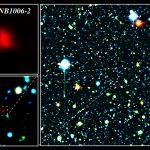W. M. Keck Observatory press release…
Using a new age-dating method and the W. M. Keck Observatory on Maunakea, an international team of astronomers have determined that ancient star clusters formed in two distinct epochs – the first 12.5 billion years ago and the second 11.5 billion years ago. These results are being published in Monthly Notices of the Royal Astronomical Society.

“We now think that globular clusters formed alongside galaxies rather than significantly before them,” research team leader, Professor Duncan Forbes of Swinburne University of Technology said.
The new estimates of the star cluster average ages were made possible using data obtained from the SAGES Legacy Unifying Globulars and GalaxieS (SLUGGS) survey, which was carried out on Keck Observatory’s 10-meter, Keck II telescope. Observations were carried out over years using the powerful DEIMOS multi-object spectrograph fitted on Keck II, which is capable of obtaining spectra of one hundred globular clusters in a single exposure.
DEIMOS breaks the visible wavelengths of objects into spectra, which the team used to reverse-engineer the ages of the globular clusters by comparing the chemical composition of the globular clusters with the chemical composition of the Universe as it changes with time.

